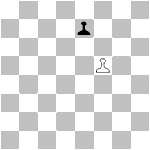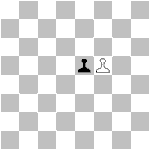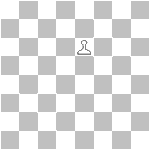Chess is perhaps the most popular board game of all time. While many people are familiar with the basic rules of chess, there is one obscure move related to pawns that most players are unaware of.
Let us first review the basic rules governing the movement of pawns in chess. From their initial position, pawns are allowed to move either one or two spaces forward (provided that there are no pieces blocking their path). After being moved from their initial position, pawns can only move one space forward provided that there are no obstructing pieces.
Pawns capture opponent's pieces by moving diagonally one space. Taking en passant is an additional way that pawns are allowed to capture opponent's pawns. Suppose that the chess game has progressed and I have advanced my my pawn three spaces from its initial position (figure 1). Now consider one of the columns to the right or left of my pawn. If you advanced your pawn from its original position two squares forward, it would occupy the square next to mine (figure 2). I am allowed to move diagonally to the space behind your pawn (to the spot you would have occupied had you only moved one space forward), and capture the pawn you just moved (figure 3)! With the en passant rule, I am able to capture your pawn as if it had moved one space forward even though it moved two spaces forward. I am only allowed, however, to take your pawn en passant in the move immediately after your movement of the pawn in question.
 |
 |
 |
| figure 1 | figure 2 | figure 3 |











